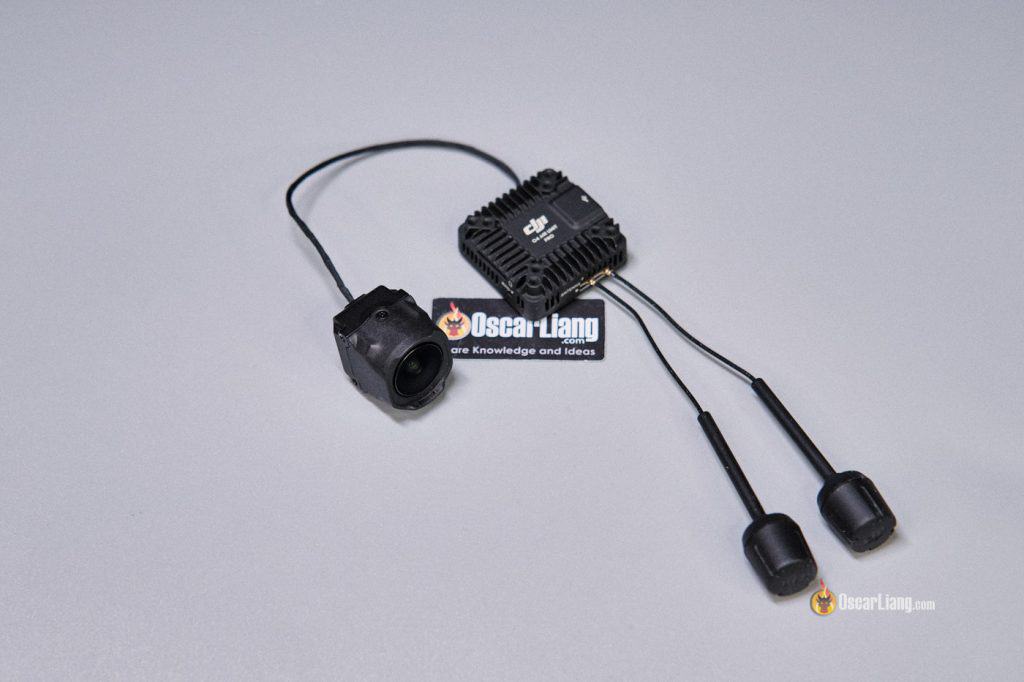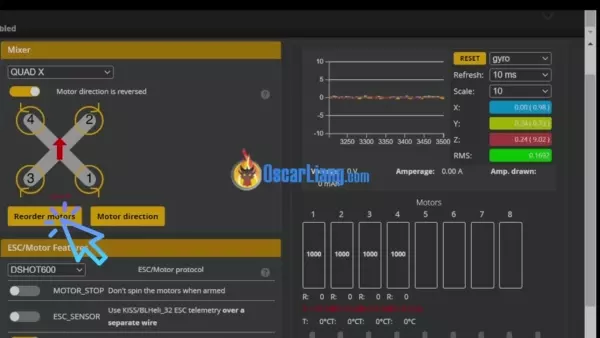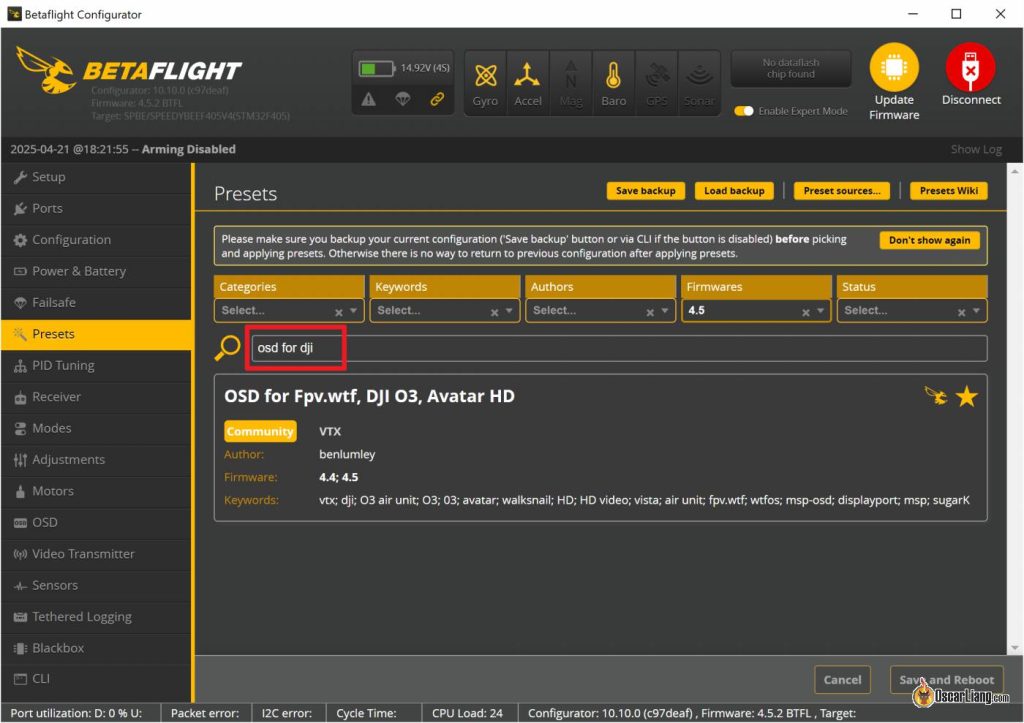16.7K
On this complete tutorial, I’ll stroll you thru the method of constructing an FPV drone from scratch, offering detailed steerage for each analogue and digital FPV techniques. We’ll cowl every thing from choosing the suitable elements, to wiring and meeting, and even share insider suggestions and tips to make sure you have a dependable and gratifying FPV drone expertise.
A number of the hyperlinks on this web page are affiliate hyperlinks. I obtain a fee (at no further value to you) for those who make a purchase order after clicking on one among these affiliate hyperlinks. This helps help the free content material for the group on this web site. Please learn our Affiliate Hyperlink Coverage for extra data.
Can Novices Construct FPV Drones?
Completely! Even when you’ve got no prior expertise, freshmen can completely construct FPV drones.
Positive, it is likely to be tempting to easily purchase a ready-made drone off the shelf—however the place’s the enjoyable (and studying) in that? By assembling your individual drone from scratch, you’ll acquire useful hands-on information about every part and the way all of them work collectively. You’ll even be a lot better ready to troubleshoot and restore your drone if something goes unsuitable.
Now, I received’t sugar-coat it—constructing your first FPV drone can be difficult. It could take hours, and even days, to finish. Alongside the way in which, you’ll want to hunt recommendation from skilled pilots on-line or determine issues out via trial and error. However belief me—the sense of accomplishment and the abilities you acquire will make the journey extremely rewarding.
So, let’s dive in and embrace the challenges forward!
Mastering the Fundamentals
Earlier than we embark on this thrilling tutorial, it’s essential to familiarize your self with the fundamentals of a quadcopter.
To get began, take a look at our beginner-friendly information: Getting Began with FPV Drone.
As you discover the world of FPV, you’ll doubtless encounter many acronyms and technical phrases. Don’t let these intimidate you! When doubtful, discuss with our useful glossary: Decoding Acronyms and Technical Phrases in FPV.
Elements Checklist
On this tutorial, we’ll be utilizing the next components to information you thru the FPV drone constructing course of.
Only a fast word: the hyperlinks offered are affiliate hyperlinks. Making a purchase order via these hyperlinks received’t value you something further, however it should earn me a small fee. This help helps hold the weblog working and permits me to proceed sharing my ardour for FPV drones with you—thanks!
This specific construct focuses on the DJI O4 Professional Air Unit. Should you’re eager about constructing an analog FPV drone, take a look at my different construct log right here: https://oscarliang.com/how-to-build-fpv-drone-analog/
When you’ve got a small price range, right here is a listing of the most affordable 5″ drone components.
If you would like extra choices, right here is a listing of components that I like to recommend.
Body
The body is the sturdy construction that holds all the drone’s elements collectively.
For this tutorial, I’ve chosen the GEPRC Vapor—a wonderful selection due to its excessive construct high quality. It additionally comes with quite a lot of 3D-printed equipment, making for an extremely simple and clear construct.
Take a look at my detailed assessment of this body, together with step-by-step meeting directions, right here: https://oscarliang.com/geprc-vapor-x5-d5-frame/.
FC and ESC
Shopping for the flight controller (FC) and ESC collectively as a stack just isn’t solely extra inexpensive, nevertheless it additionally ensures that they’re plug-and-play proper out of the field, making the drone constructing course of a lot smoother and extra simple.
For this tutorial, I’ve chosen the Speedybee F405 V4 stack. Regardless of being one of the crucial inexpensive FC/ESC stacks in the marketplace, it doesn’t compromise on options. It helps virtually all fashionable functionalities you’d need in an FPV drone. Take a look at my in-depth assessment of the Speedybee F405 V4 right here: https://oscarliang.com/speedybee-f405-v4/.
If the Speedybee F405 V4 is out of inventory, don’t fear—there are many wonderful options. Right here’s a listing of my prime suggestions: https://oscarliang.com/flight-controller/#The-Finest-FC-Suggestions.
Motors
FPV motors at the moment are surprisingly comparable by way of efficiency, particularly on the newbie stage. Which means there’s no want to purchase the costliest motors while you’re simply beginning out—most individuals wouldn’t even discover the distinction. Price range choices just like the EMAX ECO II sequence are greater than sufficient for freshmen.
For a 5-inch FPV drone, motor sizes comparable to 2306, 2207, and 2208 are all viable decisions. Personally, I consider 2207 hits the candy spot by way of performance-to-weight ratio. Study extra in regards to the variations right here: https://oscarliang.com/2306-2207-mini-quad-motor/
One other necessary issue to contemplate is motor KV, which is linked to your battery voltage. For a 6S construct, I like to recommend selecting motors with a KV ranking between 1600 and 2000. Increased KV motors ship extra aggressive and power-hungry efficiency. On this construct, I’ve chosen 1900KV motors, as the subsequent decrease possibility (1700KV) feels a bit too low for my style.
There are lots of different wonderful motors value contemplating—take a look at my full checklist of suggestions right here: https://oscarliang.com/motors/#Suggestions
FPV Setup
There are a number of FPV techniques obtainable in the marketplace, however the DJI O4 Professional could be my best choice for a 5-inch freestyle drone. It affords the very best picture high quality and sign reliability, and top-notch construct high quality. If you wish to be taught extra in regards to the completely different FPV techniques and their professionals and cons, take a look at my purchaser’s information: https://oscarliang.com/fpv-system/
Radio Receiver
Your selection of radio transmitter dictates the kind of receiver (RX) you should use. Should you adopted my radio suggestions, your radio ought to help ExpressLRS (ELRS), which is at the moment my best choice for a radio hyperlink. ExpressLRS is inexpensive, high-performance, and extremely dependable: https://oscarliang.com/expresslrs/
Quite a few producers produce receivers and transmitter modules for ExpressLRS. You possibly can select any of those, and so long as they’re ExpressLRS, they’ll work collectively. For this tutorial, I’ve chosen the BetaFPV ELRS 2.4GHz Nano, which is likely one of the cheaper choices in the marketplace and works properly.
That will help you arrange ExpressLRS, I’ve put collectively a step-by-step tutorial: https://oscarliang.com/setup-expresslrs-2-4ghz/
To fly a quadcopter in FPV, you’ll want the next equipment. Check out my on a regular basis gear for inspiration. Here’s a abstract:
Instruments and Provides
To construct the drone, you’ll additionally want the next instruments and provides. You might have already got a few of these gadgets, if not, they need to be simply discovered on-line or at your native ironmongery shop.
Important:
Elective however really useful:
For these actually passionate in regards to the interest, right here’s a complete checklist of instruments that you could be discover invaluable in your FPV drone-building journey.
Steps of Constructing FPV Drone
Click on the hyperlink will take you to the part on this article:
1. Body Meeting
Comply with my detailed step-by-step tutorial to assemble the GEPRC Vapor body: https://oscarliang.com/geprc-vapor-x5-d5-frame/
You have to full the body meeting to this stage earlier than shifting on to the subsequent steps.
2. Putting in Motors
Now, it’s time to mount the 4 motors onto the arms.
The EMAX ECO II motors include screws of various lengths. Use the screws with a 7mm thread size, that are appropriate for 5mm thick arms.
It’s extremely really useful to make use of threadlocker (comparable to Loctite) on the motor screws, as vibrations could cause them to loosen over time.
Some motors include threadlocker pre-applied (showing as a blue coating on the threads), however the ECO II motors don’t, so that you’ll want to use it your self.
Some builders use solely three screws and even two to avoid wasting weight, however I like to recommend utilizing all 4 screws for max sturdiness.
Vital: Earlier than totally tightening the motor screws, ensure that they aren’t too lengthy and aren’t urgent towards the motor windings. Should you’re uncertain, comply with this information: https://oscarliang.com/check-motor-screws-touching-winding/
3. Wiring Diagrams
Should you’re utilizing the elements I really useful, discuss with this wiring diagram for steerage.
Earlier than slicing and soldering any wires, you possibly can “dry match” all of the elements within the body. This course of means that you can gauge how lengthy the wires must be, decide the very best location in your elements, and determine any potential spacing points.
4. Putting in ESC
Begin by putting in the 4 lengthy bolts that include the Vapor body into these holes.
Slide the 4in1 ESC and FC boards onto the bolts.
Usually, the ESC’s energy pads (+ and -) ought to face the rear. Nonetheless, as a result of the Vapor body routes the battery lead via the center, it’s greatest to rotate the ESC 180 levels. This implies you’ll should remap the motor order later in Betaflight (don’t fear, I’ll clarify how).
Verify rigorously, nothing ought to contact between the underside of the ESC and the body, and between the ESC and FC boards.
Subsequent, we’ll solder the motors to the ESC. Should you’re new to soldering, discuss with the tutorial “The right way to Solder for Novices“.
There are three frequent methods to route and solder motor wires:
- Easy and informal routing: Simply solder the wires on to the ESC pads. It’s quick and straightforward, however the construct received’t look as clear. If you’re not good with soldering, do that.
- Neat routing round stack screws: Wires loop neatly across the screws. Appears cleaner however barely heavier as a consequence of longer wires (a number of further grams).
- Tight, stacking routing (my favourite): Wires are lower as brief as attainable. Very clear aesthetic, however tougher to solder because the wires are stacked on prime one other.
Safe the motor wires on the arms with material tape or electrical tape. The Vapor body equipment contains plastic tubes for wire safety, they do look neat {and professional}, however I discovered them impracticable and heavy.
Measure and lower motor wires, it’s at all times higher to go away a bit slack.
Strip about 2mm off the tip of the wires and tin the ends.
Tin all of the motor pads on the 4in1 ESC (fill the pads with a pleasant dome of solder first earlier than soldering the wires).
Don’t fear in regards to the order of the motor wires—you possibly can simply reverse motor spin route later in Betaflight.
Now, solder the capacitor that comes with the Speedybee stack. Insert the offered heatshrink tubes, shorten and bend the legs.
Solder the capacitor onto the battery pads (+ and -) on the ESC. Take note of polarity – the damaging leg is marked by a light-colored stripe on the capacitor.
Why a Capacitor?
A capacitor reduces voltage spikes and electrical noise from the motors and ESC, defending your electronics in addition to decreasing noise attending to the gyro, enhancing the flight efficiency of your drone. Study extra about why capacitors are necessary: https://oscarliang.com/capacitors-mini-quad/
The capacitor can now sit securely contained in the included TPU mount.
Now, solder the XT60 energy result in the facility pads on the ESC, take note of polarity (optimistic and damaging). That is maybe probably the most difficult step on this construct, because of the quantity of warmth required to soften the solder on the massive copper pads and thick wires. Be affected person and use the next temperature in your iron.
Soldering Ideas:
- Use quantity of solder and solder flux (solder paste) for the massive pads, guaranteeing the solder joints are shiny and full. Should you can see the wire strands, you haven’t utilized sufficient solder.
- Apply extra flux if the solder “sticks” to the tip while you take away it from the joint.
- Be at liberty to make use of a excessive temperature when soldering giant solder pads, however be fast and keep away from overheating the pads for too lengthy. Use 450°C (840°F) for motor wires and XT60, and 380°C for sign wires.
5. Testing ESC and Motors
We’ll now take a look at the ESC and motors by connecting the battery.
However earlier than plugging in a LiPo battery for the primary time, guarantee there aren’t any electrical shorts. Utilizing a multimeter in continuity mode, take a look at the optimistic and damaging terminals of the XT60 (or straight on the ESC energy pads). If there’s a brief circuit, the multimeter will beep constantly. On this case, don’t plug within the battery, as it could harm your elements. As an alternative, troubleshoot and repair the difficulty that’s inflicting the brief circuit.
For extra data on utilizing a multimeter to check your drone, take a look at this tutorial.
Professional-Tip: A brief beep adopted by silence could happen when testing continuity as a consequence of capacitors charging. That is regular and shouldn’t trigger concern. So long as it stops beeping after a second or two you have to be tremendous.
Now, join the FC to the ESC utilizing the offered 8-pin cable, and join the FC to your pc by way of a USB cable.
It’s extremely really useful to make use of a smoke stopper when plugging in a battery for the primary time. Whereas not necessary, it’s a helpful funding to keep away from damaging elements.
Don’t placed on propellers but.
To check the motors, plug within the battery and join the USB cable to the flight controller. Open Betaflight Configurator, and go to the Motors tab.
Select DShot300 in ESC Protocol. Click on Save and Reboot.
Now, allow motor management, and you must be capable to spin up the motors – do that one after the other, transfer the slider to round 1100 is sufficient.
You wan to verify the motor that’s spinning matches the quantity within the diagram, e.g. motor #1 is the rear proper, motor #2 is entrance proper and many others.
If the motor order is unsuitable (most definitely unsuitable as a result of we rotated the ESC 180 levels in our construct), you possibly can simply repair it by clicking the “Reorder Motors” button within the motors tab, and simply comply with the easy directions. You too can repair it utilizing CLI instructions nevertheless it’s fairly difficult, so simply use the software 🙂
As soon as the motor order is appropriate, you could confirm if they’re spinning within the appropriate route. To reverse a motor route, there are a number of methods, the best is to use the Betaflight Configurator (Motors tab) as defined right here.
Troubleshooting suggestions:
- If motors aren’t spinning, make sure the battery is related and also you’ve turned on the Quick Saver if you’re utilizing it. And the ESC ought to beep as quickly as you plug within the battery. Ensure that the ESC is related to the FC, and that the pin connections are appropriate.
- If all motors spin aside from one, that exact ESC, motor, or the ESC sign from the FC is likely to be defective. To troubleshoot, swap the non-functioning motor with a working one on the identical quad to find out if the difficulty lies with the ESC or motor.
For additional help, ask within the discussion board: https://intofpv.com
6. Receiver Setup
Begin by soldering the offered wires to the receiver.
Whereas the wire colours technically don’t matter, following a constant colour scheme makes troubleshooting a lot simpler. I like to recommend utilizing this colour coding:
- Black wire → GND (G)
- Crimson wire → 5V (V)
- White wire → TX (T)
- Yellow wire → RX (R)
The body features a TPU holder the place you possibly can neatly put the receiver in.
Wire the flight controller to the receiver like this (from FC to receiver):
- 4V5 → V (5V)
- G → G (Floor)
- T6 → R (Receiver RX)
- R6 → T (Receiver TX)
Mount the receiver and antenna securely contained in the body like this.
Now, bind your radio to the receiver by following this tutorial: https://oscarliang.com/bind-expresslrs-receivers/.
As soon as that’s achieved, we are able to arrange the receiver in Betaflight configurator:
- Go to the Ports tab and allow “Serial RX” for the UART related to the receiver (UART6 in our instance, as a result of we related it to T6 and R6). Click on Save.
- Within the Receiver tab, choose “Serial (by way of UART)” in Receiver Mode and select “CRSF” in Serial Receiver Supplier. Allow Telemetry. Click on Save.
After this, the receiver must be working. To verify, go to the Receiver tab, and the bars (channel values) ought to change while you transfer the sticks on the radio. If the unsuitable channels are responding, strive a special Channel Map comparable to “default (AETR)” or “TAER”.
You will have to setup switches on the radio for arming, flight modes and beeper. Comply with this tutorial to find out how: https://oscarliang.com/setup-switch-mixes/
When you’ve got any questions, put up within the discussion board: https://intoFPV.com
7. Putting in DJI O4 Professional
Connecting the DJI O4 Professional Air Unit to the Speedybee flight controller couldn’t be less complicated—simply plug within the offered cable and also you’re good to go. The O4 Air Unit can be mounted on prime of the receiver.
Push the 2 O4 Professional antennas securely into the holes within the rear TPU antenna mount.
Should you’re controlling the drone utilizing ExpressLRS, you might wish to take away the SBUS and GND wires from the O4 connection cable. These wires are supposed for the DJI distant controller, and leaving them related could cause conflicts for those who’re utilizing the identical UART for one more gadget.
Mount the digicam between the silicone dampers included with the body.
Should you’re new to flying, you may wish to begin with a decrease digicam tilt angle like 10° to fifteen°. As you develop into extra snug and begin flying sooner, you possibly can enhance the lean to twenty° and even 30° for higher ahead visibility at velocity.
Now we’ll configure OSD (On-Display Show) to point out necessary flight information like battery voltage, flight time, and warnings straight in your DJI goggles.
I’ve a full step-by-step information right here if you would like extra element: https://oscarliang.com/how-to-setup-dji-o4-pro/
To summarize the method:
- In Betaflight Configurator, go to the Presets tab.
- Seek for “OSD for DJI”.
- Choose the preset you discover.
- Within the choices, choose “map to displayport”, “set HDOSD”, and the UART you’ve related the O4 to (in our instance that’s UART1).
- That’s it.
Now, head to the OSD tab, allow your favorite parts and transfer them round as you would like. Ensure you’ve chosen HD below Video Format so you might be utilizing all of the display screen house obtainable. I’ve my very own OSD layouts if you wish to copy: https://oscarliang.com/betaflight-osd/#My-OSD-Setup-CLI-Instructions
8. Ending Off
Safe the flight controller (FC) with nylon nuts.
Tighten solely by hand to keep away from over-compressing the rubber grommet because it may cut back vibration damping and defeat the aim of soppy mounting.
Subsequent, set up the highest plate.
Listed below are the weights of the finished drone:
- Drone together with propellers and battery strap: 453g
- Drone + 6S 1100mAh LiPo: 645g
- Drone + 6S 1100mAh LiPo + GoPro 13: 802g
When putting in the propellers, take note of the completely different rotations—CW (clockwise) and CCW (counter-clockwise). Guarantee they’re put in on the proper motors; in any other case, your quad could not take off or may flip over when making an attempt to.
Use M5 nylon lock nuts to carry the propellers securely on the motor. Tightening is likely to be difficult at first however will develop into simpler over time. Keep away from overtightening to forestall prop hub shattering. Tighten simply sufficient so the prop can’t transfer while you attempt to rotate it together with your hand whereas holding the motor bell.
A devoted prop nut software can velocity up prop modifications.
When mounting the battery (and GoPro), make sure the COG (middle of gravity) is as near the drone’s middle as attainable. To verify if the battery is positioned accurately, seize the center of the highest plate with two fingers and see if the quad stays stage. It’s important to take care of the COG on the middle of the 4 motors. As an illustration, if the quad is front-heavy, the entrance motors will work tougher than the rear motors when making an attempt to take care of its place, negatively impacting flight efficiency.
And we’re prepared for a take a look at flight!
9. Setting Up Betaflight
We’ve already coated a lot of the Betaflight setup throughout this construct. Nonetheless, to double-check every thing and guarantee nothing is missed, comply with my full newbie’s tutorial right here: https://oscarliang.com/betaflight-firmware-setup/
10. Tuning
Tuning your quadcopter entails adjusting it to fly and behave the way in which you need. Betaflight has come a good distance; you don’t should tune your quad, and it’ll doubtless fly simply tremendous with inventory settings. Nonetheless, for those who’re severe about efficiency, there’s extra to be taught!
For most individuals, tuning an FPV drone entails adjusting these settings:
Tuning is kind of technical and typically entails using Blackbox logs. Should you don’t know the best way to use Blackbox, that is the best way to tune your FPV drone in 10 easy steps. Should you’re accustomed to Blackbox, take a look at this in-depth information on tuning filters and PID.
Earlier than tuning, although, I’d suggest flashing Bluejay firmware to the ESC if they arrive with BLHeli_S firmware, it provides you with higher efficiency. When doing so, you’ll want to decide on between the 24kHz or 48kHz variations. The 24kHz model supplies higher responsiveness and torque, whereas the 48kHz model affords smoother flight with barely much less torque. I like to recommend 48KHz. You too can allow bi-directional Dshot, and activate RPM filter when you’ve flashed Bluejay. It’s among the best filters obtainable in Betaflight and makes your quad flies higher.
I’ll share my PID and Filter tune for this construct in my Patreon shortly, if you wish to strive my tune, think about subscribing: https://oscarliang.com/patreon-support-announcement/
11. Studying The right way to Fly
When you’ve got little to no expertise flying a mini quad, think about testing these tutorials to get began:
When you’ve got any questions, be happy to ask within the feedback.
You possibly can verify my previous construct guides (some information is outdated):


































































